Poetry & Poets
Explore the beauty of poetry – discover the poet within

How To Write A Poetry Research Paper

Introduction
Writing a poetry research paper can be an intimidating task for students. Even for experienced writers, the process of writing a research paper on poetry can be daunting. However, there are a few helpful tips and guidelines that can help make the process easier. Writing a research paper on poetry requires the student to have an analytical understanding of the poet or poet’s work and to utilize multiple sources of evidence in order to make a convincing argument. Before starting the research paper, it is important to properly analyze the poem and to understand the form, structure, and language of the poem.
The process of writing a research paper requires numerous steps, beginning with researching the poet and poem. If a poet is unknown, the research process must be started by learning about their biography, other works, and their impact on society. With online databases, libraries, and archives the research process can move quickly. It is important to carefully document sources for later use when creating bibliographies for the paper. Once the process of researching the poem has been completed, the next step is to analyze the poem itself. It is important for the student to read the poem carefully in order to understand the meaning, as well as its tone, imagery, and metaphors. Furthermore, analyzing other poems by the same poet can help students observe patterns, trends, or elements of a poet’s work.
Outlining and Structure
Outlining the research paper is just as important as analyzing the poem itself. Many students make the mistake of not taking enough time to craft a detailed outline that follows the structure of the paper. An effective outline will make process of writing the research paper more efficient, allowing for ease of transitions between sections of the paper. When writing the paper, it is important to think through the structure of the paper and how to make a strong argument. Support for the argument should be based on concrete evidence, such as literary criticism, literary theory, and close readings of the poem. It is essential to have a clear argument that is consistent throughout the body of the paper.
Citing Sources
When writing a research paper it is also important to cite all sources that are used. The style used for citing sources will depend on the style guide indicated by the professor or the school’s guidelines. Whether using MLA, APA, or Chicago style, it is important to adhere to the style guide indicated in order to have a complete and well-written paper.
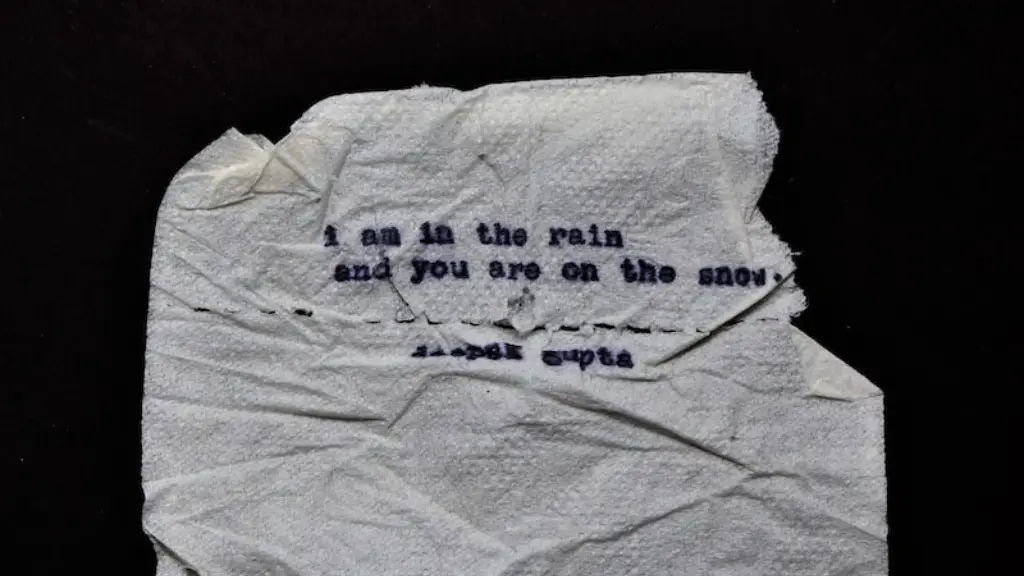
Once the research and outlining is complete, the process of drafting a poetry research paper can begin. When constructing the first draft, it is especially useful to re-read the poem and to recall evidence that supports the argument made about the poem. Additionally, it is important to proofread and edit the first draft in order to make the argument more clear and to check for any grammar or spelling errors.
Writing a research paper on poetry does not have to be a difficult task. By taking the time to properly research, analyze, and structure the paper, the process of writing a successful poetry research paper becomes easier. Following these steps— researching the poet, understanding the poem itself, outlining the paper, citing sources, and drafting the paper— will ensure a great and thorough paper is prepared.
Using Imagery and Metaphor
The use of imagery and metaphor is an essential element when writing poetry. Imagery can be used to provide vivid descriptions of scenes and characters, while metaphor can be used to create deeper meanings and analogies. Understanding the use of imagery and metaphor can help to break down the poem and discover hidden meanings. Students researching poetry should pay special attentions to the poetic devices used to further the story or allusions to other works, such as classical mythology. Paying close attention to the language, metaphors, and imagery used by the poet can help to uncover the true meaning of the poem. By breaking down the element of the poem and focusing on individual elements, it is much easier to make valid conclusions about the poem and its author.
Understanding Rhyme and Meter
Rhyme and meter are two of the most important and complex elements of poetry. These two poetic techniques are used to help the poet structure their poem to provide rhythm and flow. Most commonly, rhyme and meter help to provide emphasis to certain words or phrases to give them additional meaning. When analyzing poetry, it is important to pay attention to the written rhyme schemes and meter of the poem. There are various patterns of rhyme, such as couplets, tercets, and quatrains. Meter, usually governed by iambs and trochees, can give the poem an added sense of rhythm to further emphasize certain words, phrases, or thoughts.
Exploring Themes

Themes are the central ideas behind a poem. The themes of a poem can be subtle and can be found in the language and images used. Exploring the poem through a thematic analysis can help to identify the true meaning of the poem and the message that the poet is conveying. When researching a poem, it is important to identify the primary theme of the poem and to look for evidence in the poem that can be used to support the claim. By paying attention to the language of a poem, students can uncover the deeper meanings within the poem and can move past the literal interpretation of the poem.
Analyzing Discourse and Context
In addition to the written aspects of a poem, it is important to consider the historical and social context of the poem. The context of the poem can be used to further understand its deeper meanings and implications. Collingwood’s theory of re-enactment can be used to reconstruct the context of a poem in order to gain a deeper understanding of the poem. When researching a poem, it is important to consider the the time period in which the poem was written, the author’s other works, and the broader literary context of the poem. Examining the discourse used by the poet can help to uncover the true message of the poem and the impact on society at the time.
Finding Inspiration
When researching poetry, it is important for the student to find inspiration in the form of other authors, critics, and theorists. Studying the works of other authors can provide valuable insight into a poem and can inform the student’s own interpretations. In addition to studying critics and theorists, the student should also look to other poets and authors as sources of inspiration. The student can explore the works of similar poets or authors to learn how they use their poetic elements in their work. This can help students to gain insight into the language, imagery, and themes present in the poem being researched.

Minnie Walters
Minnie Walters is a passionate writer and lover of poetry. She has a deep knowledge and appreciation for the work of famous poets such as William Wordsworth, Emily Dickinson, Robert Frost, and many more. She hopes you will also fall in love with poetry!
Leave a Comment Cancel reply
- Tools and Resources
- Customer Services
- Original Language Spotlight
- Alternative and Non-formal Education
- Cognition, Emotion, and Learning
- Curriculum and Pedagogy
- Education and Society
- Education, Change, and Development
- Education, Cultures, and Ethnicities
- Education, Gender, and Sexualities
- Education, Health, and Social Services
- Educational Administration and Leadership
- Educational History
- Educational Politics and Policy
- Educational Purposes and Ideals
- Educational Systems
- Educational Theories and Philosophies
- Globalization, Economics, and Education
- Languages and Literacies
- Professional Learning and Development
- Research and Assessment Methods
- Technology and Education
- Share This Facebook LinkedIn Twitter
Article contents
Poetic approaches to qualitative data analysis.
- Qiana M. Cutts Qiana M. Cutts Mississippi State University
- and M. Billye Sankofa Waters M. Billye Sankofa Waters The University of Washington Tacoma
- https://doi.org/10.1093/acrefore/9780190264093.013.993
- Published online: 28 August 2019
Poetic inquiry, an increasingly popularized form of arts-based research, is an expressive and evocative method and methodology, where the lines of responsibility and roles assumed of a researcher mandate that the researcher is a social science and expressive artist. It is defined broadly as a reseach process and research product. As a process, poetic inquiry is the foundation of or central component to research endeavors where poetry can be the data source, the analytical and interpretative lenses, and/or the presentation. As a product, poetic inquiry results in poems singularly constructed by the researcher or participants or collaboratively crafted with both researcher and participants using notes, transcripts, memos, documents, texts, and so on. While all research is the interpretation of one voice through yet another voice, poetic inquiry offers the opportunity for participants to truly speak for themselves.
The emergence of poetry within arts-based research is connected not only to the overall increase in arts-based practices but also to broader epistemological and theoretical insights such as those posed by postmodern and post-structural theory. As such, feminist and other politically motivated researchers may be interested in the transformational possibilities of poetry, as poetry can be a vehicle through which the patriarchal suffocation of research can be challenged. Thus, many researchers utilizing poetic inquiry focus on race, gender, identity, social justice, etc.
As with any research, there are methodological and quality-related criticisms of poetic inquiry. However, poetic inquiry researchers acknowledge poetic inquiry is subjective, emotional, complex, connected, and sometimes messy in that it is constantly evolving, influencing, and being influenced by the social world. The quality of poetry used in and presented as poetic inquiry is more of a concern than a critique as arts-based researchers steer clear of promoting the minimized accessibility of poetic inquiry that would be the result of poetic elitism. Nevertheless, poetic inquiry researchers must consider the quality of their poetic inquiry work. They should study the craft of poetry, be aware of the traditions, understand the techniques, and engage in reflection prior to and while conducting any research project.
There are a number of considerations to be had regarding the future directions of poetic inquiry. First, poetic inquiry continues to grow and bear fruit. If researchers are to employ convincingly poetic inquiry, they cannot be bound by draconian definitions. Poetic inquiry is not a welcome all for poorly constructed poetry; however, advocating for tightly bound definitions of work that is intended to be exploratory, evocative, and expressive would debilitate the field. Next, while there are some generally accepted and expected practices, there is no mandated linear process one must employ in poetic inquiry. The continued evolution of the poetic inquiry process is expected. Finally, the impact of poetic inquiry has been increasing steadily for at least 15 years as researchers have become more interested in engaging, questioning, refining, and adopting poetic inquiry. A journal dedicated specifically to defining, exploring, and presenting poetic inquiry could further this impact.
- arts-based research
- qualitative analysis
- poetic inquiry
- reflexivity
You do not currently have access to this article
Please login to access the full content.
Access to the full content requires a subscription
Printed from Oxford Research Encyclopedias, Education. Under the terms of the licence agreement, an individual user may print out a single article for personal use (for details see Privacy Policy and Legal Notice).
date: 29 April 2024
- Cookie Policy
- Privacy Policy
- Legal Notice
- Accessibility
- [66.249.64.20|185.194.105.172]
- 185.194.105.172
Character limit 500 /500
Fordham Library News
The latest from the Fordham University Libraries
A Guide to Researching Poetry
By Jeannie Hoag, Reference and Assessment Librarian

Tips for Researching Poetry
Among many other delightful signs of spring, April brings us National Poetry Month. Springtime during a pandemic is a contradictory mix of delights and shadows –an imperfectly perfect opportunity for poetry.
This is the 25th year we’ve been graced with National Poetry Month . If you regularly recognize National Poetry Month, it might be a welcome reminder of normalcy. And if you’ve never celebrated this month but want to dip your toe into the waters of the poetry pond, you’ve chosen a great time to explore. Below, you will find a few tips to help you get started with poetry research. A proposal: keep it simple, and let subject terms do the hard work for you.
Tip #1: Start Local
First, let’s look at what’s happening on the local front. The library catalog makes it easy to identify works by Fordham faculty. Add in a few well-chosen limiters, and you can quickly pull together a list of books to dig into.
For example, by using the library catalog’s Advanced Search view, you can search using the subject terms “Fordham faculty author” and “poetry.” You’ll come away with a list of books of poetry, or books about poetry, by our very own faculty members. (This works for other topics, too.)
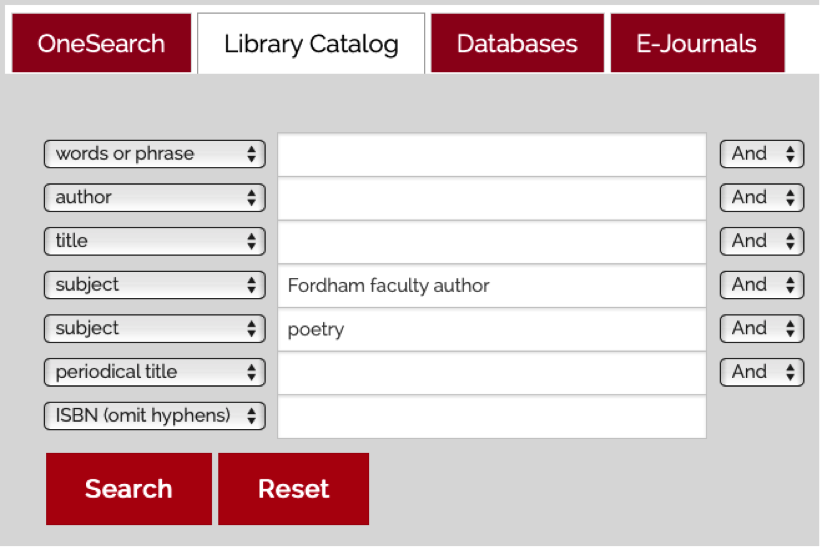
If you’re interested in exploring beyond Fordham, you can simply use the subject term “poetry” to find all the resources that are poetry-related. With over 35,000 results, that may be a bit overwhelming, so consider using some of these more specific subject terms:
- Narrative poetry
- Prose poems
- Modern poetry
- Jesuit poetry
And for focusing on poetry craft and technique, consider:
- Poetry authorship
- Poetry teaching
- Poetry criticism
If you’re able to visit the Walsh or Quinn libraries, might enjoy browsing by using this list of Library of Congress call numbers for Languages and Literatures . Some of the best discoveries come by way of serendipity. Even easier, pay a visit to the Poetry Room on the 3rd floor of Walsh Library, where you’ll find poetry spanning continents and centuries.
Tip #2: Get Specialized
Do you have a specific poetry need? Maybe a line has been zipping around, unidentified, all week. Or perhaps you’re officiating a wedding, dedicating a building, or tasked with making a public pronouncement that would benefit from a well-chosen poem.
Whatever your scenario, try Columbia Granger’s World of Poetry . This database provides a hearty amount of information, including the full text of some poems, author information, and subject indexing (497 poems about hair, 2 about haggis). It even notes applicable anthologies.

As with all our databases, you can locate Columbia Granger’s via the Databases tab on the library website. The advanced search option gives you maximum control, while the browse option is great for those who are just looking.
Tip #3: Expand Your Horizons
As you can see, the field of poetry is delightfully nuanced. If you’ve exhausted Fordham Libraries’ coverage of your area of interest, look globally to WorldCat .
WorldCat is a powerhouse “world catalog,” and is located on the library website under Resources .
Using the same Library of Congress subject terms you used in your library catalog search, you can see what’s available on your topic at libraries worldwide. For example, using the advanced search option in WorldCat, you can search for other books with the subject of poetry authorship.

In the results, books at Fordham are clearly labeled.

Find something interesting that’s not at Fordham? You can request it through ILLiad, our interlibrary loan service . And if it’s something you think Fordham should have, you can suggest it for purchase .
The Fordham Libraries has many excellent books and great databases for researching poetry. Whether you’re looking for literary criticism, biographies, or individual poems, we’ve got you covered. The Poetry research guide is full of recommended resources. Not finding what you’re looking for? Just ask a librarian. Our chat service is staffed 24/7, and you can also email our library liaisons directly.

More From the Blog

World Tai Chi & QiGong Day

Classics Reimagined

EH -- Researching Poems: Strategies for Poetry Research
- Find Articles
- Strategies for Poetry Research
Page Overview
This page addresses the research process -- the things that should be done before the actual writing of the paper -- and strategies for engaging in the process. Although this LibGuide focuses on researching poems or poetry, this particular page is more general in scope and is applicable to most lower-division college research assignments.
Before You Begin
Before beginning any research process, first be absolutely sure you know the requirements of the assignment. Things such as
- the date the completed project is due
- the due dates of any intermediate assignments, like turning in a working bibliography or notes
- the length requirement (minimum word count), if any
- the minimum number and types (for example, books or articles from scholarly, peer-reviewed journals) of sources required
These formal requirements are as much a part of the assignment as the paper itself. They form the box into which you must fit your work. Do not take them lightly.
When possible, it is helpful to subdivide the overall research process into phases, a tactic which
- makes the idea of research less intimidating because you are dealing with sections at a time rather than the whole process
- makes the process easier to manage
- gives a sense of accomplishment as you move from one phase to the next
Characteristics of a Well-written Paper
Although there are many details that must be given attention in writing a research paper, there are three major criteria which must be met. A well-written paper is
- Unified: the paper has only one major idea; or, if it seeks to address multiple points, one point is given priority and the others are subordinated to it.
- Coherent: the body of the paper presents its contents in a logical order easy for readers to follow; use of transitional phrases (in addition, because of this, therefore, etc.) between paragraphs and sentences is important.
- Complete: the paper delivers on everything it promises and does not leave questions in the mind of the reader; everything mentioned in the introduction is discussed somewhere in the paper; the conclusion does not introduce new ideas or anything not already addressed in the paper.
Basic Research Strategy
- How to Research From Pellissippi State Community College Libraries: discusses the principal components of a simple search strategy.
- Basic Research Strategies From Nassau Community College: a start-up guide for college level research that supplements the information in the preceding link. Tabs two, three, and four plus the Web Evaluation tab are the most useful for JSU students. As with any LibGuide originating from another campus, care must be taken to recognize the information which is applicable generally from that which applies solely to the Guide's home campus. .
- Information Literacy Tutorial From Nassau Community College: an elaboration on the material covered in the preceding link (also from NCC) which discusses that material in greater depth. The quizzes and surveys may be ignored.
Things to Keep in Mind
Although a research assignment can be daunting, there are things which can make the process less stressful, more manageable, and yield a better result. And they are generally applicable across all types and levels of research.
1. Be aware of the parameters of the assignment: topic selection options, due date, length requirement, source requirements. These form the box into which you must fit your work.
2. Treat the assignment as a series of components or stages rather than one undivided whole.
- devise a schedule for each task in the process: topic selection and refinement (background/overview information), source material from books (JaxCat), source material from journals (databases/Discovery), other sources (internet, interviews, non-print materials); the note-taking, drafting, and editing processes.
- stick to your timetable. Time can be on your side as a researcher, but only if you keep to your schedule and do not delay or put everything off until just before the assignment deadline.
3. Leave enough time between your final draft and the submission date of your work that you can do one final proofread after the paper is no longer "fresh" to you. You may find passages that need additional work because you see that what is on the page and what you meant to write are quite different. Even better, have a friend or classmate read your final draft before you submit it. A fresh pair of eyes sometimes has clearer vision.
4. If at any point in the process you encounter difficulties, consult a librarian. Hunters use guides; fishermen use guides. Explorers use guides. When you are doing research, you are an explorer in the realm of ideas; your librarian is your guide.
A Note on Sources
Research requires engagement with various types of sources.
- Primary sources: the thing itself, such as letters, diaries, documents, a painting, a sculpture; in lower-division literary research, usually a play, poem, or short story.
- Secondary sources: information about the primary source, such as books, essays, journal articles, although images and other media also might be included. Companions, dictionaries, and encyclopedias are secondary sources.
- Tertiary sources: things such as bibliographies, indexes, or electronic databases (minus the full text) which serve as guides to point researchers toward secondary sources. A full text database would be a combination of a secondary and tertiary source; some books have a bibliography of additional sources in the back.
Accessing sources requires going through various "information portals," each designed to principally support a certain type of content. Houston Cole Library provides four principal information portals:
- JaxCat online catalog: books, although other items such as journals, newspapers, DVDs, and musical scores also may be searched for.
- Electronic databases: journal articles, newspaper stories, interviews, reviews (and a few books; JaxCat still should be the "go-to" portal for books). JaxCat indexes records for the complete item: the book, journal, newspaper, CD but has no records for parts of the complete item: the article in the journal, the editorial in the newspaper, the song off the CD. Databases contain records for these things.
- Discovery Search: mostly journal articles, but also (some) books and (some) random internet pages. Discovery combines elements of the other three information portals and is especially useful for searches where one is researching a new or obscure topic about which little is likely to be written, or does not know where the desired information may be concentrated. Discovery is the only portal which permits simul-searching across databases provided by multiple vendors.
- Internet (Bing, Dogpile, DuckDuckGo, Google, etc.): primarily webpages, especially for businesses (.com), government divisions at all levels (.gov), or organizations (.org). as well as pages for primary source-type documents such as lesson plans and public-domain books. While book content (Google Books) and journal articles (Google Scholar) are accessible, these are not the strengths of the internet and more successful searches for this type of content can be performed through JaxCat and the databases.
NOTE: There is no predetermined hierarchy among these information portals as regards which one should be used most or gone to first. These considerations depend on the task at hand and will vary from assignment o assignment.
The link below provides further information on the different source types.
- Research Methods From Truckee Meadows Community College: a guide to basic research. The tab "What Type of Source?" presents an overview of the various types of information sources, identifying the advantages and disadvantages of each.
- << Previous: Find Books
- Last Updated: Apr 19, 2024 7:27 AM
- URL: https://libguides.jsu.edu/litresearchpoems

- Spartanburg Community College Library
- SCC Research Guides
ENG 102 - Poetry Research
- 7. Write Your Paper
Write Your Paper/Project
Getting started.
- Writing Fundamentals from Writer's Reference Center This has links to articles on writing any document, paraphrasing, quotations, writing a thesis statement, outline, body paragraphs, conclusion, and writing about themes, characters, form, symbols, etc.
- Choosing a Research Topic and Creating a Thesis This guide from the SCC Library provides students information on how to choose a research topic for an assignment including what makes a good research topic, concept mapping, background research, and narrowing a topic and most importantly information about creating a thesis.
- Choosing a Topic (Tutorial) This SCC Library tutorial will walk you through how to choose an appropriate topic for a research assignment and help you turn your research topic into a thesis statement.
How to Explicate a Poem

MLA Formatting for Papers
If you're using APA Format for your paper - see our APA Guide
- Creating and Formatting MLA Paper This guide from SCC Library provides you instructions in MS Word for formatting a paper correctly including proper font and header.
- Formatting Your Works Cited Page-MLA This guide from SCC Library provides you instructions in MS Word for formatting works cited page correctly including proper font and hanging in-dent.
- Sample Paper in MLA Format Don't forget to format your paper in MLA format. This sample paper will show you how to format your paper.
- Sample MLA Paper with Block Quote Sample MLA paper that includes how do a block quote.
- MLA Guide to Undergraduate Research in Literature This helpful book will walk you through all parts of doing literary research, from how to get started doing literary research to how to find sources about literature.
- Sample Drama Paper with Line Number Citations This sample drama paper will show examples of in-text citations using line numbers.
- Sample Drama Paper with Dialog
- Citing a Play (MLA) This SCC guide shows you how to do a works cited entry and in-text citations for plays.
- Citing a Poem (MLA) This SCC guide shows you how to cite a poem on your works cited page as well as in-text.
Incorporating Sources into a Research Project & Avoiding Plagiarism
- Organizing Your Research This guide from the SCC Library provides information on creating research note cards, source tables, and research outlines to help organize your sources so that you can incorporate them into your paper.
- Incorporating Sources into a Research Project This guide from the SCC Library provides resources on how to properly include sources in a research project without plagiarism, whether through good note-taking, following the research process, or using direct quotations, paraphrasing, or summarizing, etc.
- How to Paraphrase: Avoid Plagiarism in Research Papers with Paraphrases & Quotations (3 min. video) This video explains how to paraphrase information correctly to avoid plagiarism.
- English Composition I: The Writer's Circle, Lesson 9, Part 4, Integrating Research (Video) This video talk about citing sources to avoid plagiarizing. (1 min)
Additional Resources
- Purdue Online Writing Lab (OWL) This site contains resources for writing, research, grammar, mechanics, and style guides (MLA & APA).

The Learning Center (TLC)

- Free live online tutoring and writing help, available 24/7 - TutorMe (accessed through D2L).
- Visit the TLC in-person at Giles or other campuses. Visit the TLC Portal Page (SCC Log in Required) for hours and English and Computer tutor availability.
- Email your paper/project to them at [email protected] . They offer a 48 hour turn-around on papers (excluding weekends and holidays), and ask that you send a copy of the assignment as well. The paper needs to be Microsoft Word format (don't share a copy of your OneDrive/cloud account), and please include your due date and SCC college ID number in the email.
Visit the The Learning Center located in the P. Dan Hull Building, rooms E2, E5, E6. See TLC Portal Page (SCC log in required) for additional locations. Contact The Learning Center for more information .
- << Previous: 6. Evaluate Your Sources
- Next: Literary Criticism Guide >>
- 1. Getting Started
- 2. Explore Your Topic
- 3. Narrow Your Topic
- 4. Find Sources
- 5. Cite Your Sources
- 6. Evaluate Your Sources
- Literary Criticism Guide
Questions? Ask a Librarian

- Last Updated: Mar 7, 2024 5:09 PM
- URL: https://libguides.sccsc.edu/Poetry
Giles Campus | 864.592.4764 | Toll Free 866.542.2779 | Contact Us
Copyright © 2024 Spartanburg Community College. All rights reserved.
Info for Library Staff | Guide Search
Return to SCC Website

Please Select Login Server:

- Local Securities
- China Connect
- Grade Based Margin NEW
- Stock Borrowing & Lending
- Stock Options
- Foreign Stocks
- Local Futures
- Foreign Futures
- Insurance Services
- Monthly Investment Plan
- Other Services
- Surplus Cash Facility
- Phillip Premier
- Latest Insurance Promotion
- Capital Management
- Fund Manager
- Service Plan
- Newly Listed Equities Index ETF
- Phillip Wealth Fund
- ETF Newsletter
- Research Report
Investor Notes
- Market Brief
- Dealer's Market Brief
- Foreign Stock Research Report
- A-Share Research Report
- Local and World Indices Figures
- Interest Rate
- Thematic Portfolio
- Education Center
- Course & Seminar
- Video Tutorials
- Terms and Conditions
- Mobile Apps
- Feature Comparison
- Platform News
- Security Code Generator PHK Key
- Platforms Information & Download
- PHK Key Registration
- Unbind PHK KEY
- Futures API
- Derivative Product Notice
- Open an Account
- Enquiry & Support
- Fund Management
- E-Stock_Transfer-in
- Margin and Rates
- Fees & Charges
- Download Forms
- Latest Promotion
- Important Notes
- Phillip Securities Group
- Phillip Network
- Phillip Post
- Phillip Channel
- Market Info
- Phillip Apps
- Customer Service
Report Review of March 2024
Utilities, Commodity & Metals ( Margaret Li ),
TMT, Semiconductors, Consumer & Healthcare (Eric Li)
Utilities, Commodity & Metals (Margaret Li)
This month I released reports of Jiangxi Copper Company Limited(358).
In the first three quarters of 2023 (January to September), the company's total operating revenue was 399.56 billion yuan (RMB, the same as below), a year-on-year increase of 8.53%; the total operating cost was 393.48 billion yuan, a year-on-year increase of 8.83%; operating profit was 6.49 billion Yuan, a year-on-year increase of 4.16%; of which the net profit attributable to shareholders of the parent company was 4.94 billion yuan, a year-on-year increase of 4.54%. Basic earnings per share was 1.43 yuan, a year-on-year increase of 4.54%. The company's total operating income in the third quarter was 132.03 billion yuan, a year-on-year increase of 16.93%; the net profit attributable to shareholders of listed companies after deducting non-recurring gains and losses was 1.44 billion yuan, a year-on-year increase of 30.03%. The performance mainly due to the relatively active domestic policies and demand from real estate and new energy sectors are strong, which keeps copper inventories at a low level and provides certain support for copper prices.
The company is committed to accelerating project construction with higher efficiency. Thecopper cathode project with an annual capacity of 180,000 tonnes of JCC Guoxing was successfully put into operation; the fine copper wire expansion project with an annual capacity of 10,000 tonnes of JCC Copper Products commenced coordinated commissioning in late June; the landmark sub-projects of phase III of the extension project of Wushan Copper Mine, such as 1,000-metre main shaft and auxiliary shaft were completed three months ahead of schedule; the 5,000 tonnes/day open pit project of Yinshan Mining completed all preparation works for comprehensive commencement of construction. In addition, the company has also achieved certain results in technological innovation. The “diamond-copper” product, a high-end chip cooling material developed by the Company, delivered outstanding performance in the trial mass application and had a great appeal to target customers, and the Company will seek cooperation to advance commercialisation in the future. The 6N high-purity copper, the raw material to break high-tech stranglehold in the fields of high-end electronic manufacturing and aviation, completed the midpoint testing research. The heat-proof and anti-corrosion 4N rhenium powder for use in alloys was tried out by high new technology enterprises and was highly recognised in the market. The high-performance oxygen-free copper rods for use in new energy vehicles achieved low-cost and large-scale production and sales. In addition, the company paid attention to energy conservation and emission reduction, the company recorded a period-on-period decrease of 1.39% in total energy consumption and an overall decline of about 18,000,000 kWh in purchased electricity in the first half of the year. And the company introduced new energy electric heavy-duty dump trucks in mines to apply new energy scenarios for the first time.
TMT, Semiconductors, Consumer, Healthcare (Eric Li)
This month I released reports of JNBY Design Limited (3306.HK).
Founded in 1994 and listed on the Hong Kong Stock Exchange in 2016 (stock code: 03306), JNBY is designer group in China and is headquartered in Hangzhou, China. JNBY design and sell fashion apparel, footwear, accessories and home products under a portfolio of brands in three stages, including mature brand representing JNBY, younger brands representing CROQUIS, jnby by JNBY and LESS, and emerging brands representing POMME DE TERRE, JNBYHOME. As of December 31, 2023, the total number of standalone retail stores around the world is 2,036 (including "JNBY Group +" multi-brand collection stores), sales network has covered all provinces, autonomous regions and municipalities in Mainland China and across nine other countries and regions around the world.
The total revenue for the six months ended December 31, 2023 (1HFY2024) amounted to RMB2,976 million, an increase of 26.1% YoY. The increase in revenue was mainly due to the increase in same store sales of offline shops, the growth in the sales of online channels and the increase in the scale of offline stores. Net profit was RMB574 million, representing an increase of 54.5% YoY; Net profit margin increased by 3.5 percentage points to 19.3%. The basic EPS were RMB1.14, an increase of 54.1% YoY, with an interim dividend of HK$0.46 per share (equivalent to RMB0.42 per share) and a special interim dividend of HK$0.39 per share (equivalent to RMB0.36 per share), totaling HK$0.85 per share.
1HFY2024, the gross profit increased by 27.6% YoY to RMB1,948 million; The overall gross profit margin increased by 0.8 percentage points to 65.5% , which was mainly attributable to the enhancement of the comprehensive brand equity. The selling and marketing expenses accounted for 31.1% (1HFY2023: 34.6%). The decrease in the expense ratio as compared to the first half of fiscal year 2023 was mainly attributable to the increase in the overall revenue and the improvement of operating efficiency.
As of December 31, 2023, the company had over 7.4 million membership accounts (without duplication) (as of June 30, 2023: over 6.9 million). The retail sales contributed by the members of the company accounted for over 80% of the total retail sales. The number of active members accounts of the company (without duplication) was over 550,000 (2022: over 420,000), and the number of active members accounts was significantly higher than that in 2022. The number of membership accounts with annual purchases totaling over RMB5,000 was over 300,000 (FY2022: over 220,000), and the retail sales contributed by those membership accounts reached RMB4.33 billion (FY2022: RMB2.93 billion), accounting for over 60% of the total retail sales from offline channels.
Click Here for PDF format...
- Friendship Links

We appreciate your feedback.
Your experience on our website is important to us. Please let us know how you feel about our website:
- How satisfied are you with our POEMS website? 1 Less satisfied 2 3 4 5 6 7 8 9 10 Most satisfied
- How likely are you to recommend our POEMS website to your family and friends? 1 Less Likely 2 3 4 5 6 7 8 9 10 Most Likely
- Do you have any other feedback regarding our POEMS website? (Please DO NOT include any personal information, requests or instructions)
Stock Research
Wells Fargo & Company - NII decline hurt earnings
Bank of America Corporation - Earnings hurt by NII and FICC
CapitaLand Investment Limited - Capital recycling picks up pace
Sheng siong group ltd - seasonal and base effect bump.
Tesla Inc. - Cut in volume and prices
Keppel Ltd - A slow quarter
Frasers centrepoint trust - robust operating performance in 1h24.
Spotify Technology S.A. - Raised prices and subscribers still grew
Suntec REIT - Higher-for-longer interest rate continue eroding DPU
Apr 25th - Things to Know Before the Opening Bell
- Company Reports
- Sector Report
- Strategy Report
- Credit View
Technical Analysis
- Trading Idea
- Weekly Strategy Reports
Sign up for free webinars
- Join us at our Live Counter Review through Technical Analysis
- Join Weekly Market Call
- Join SGX Listed Companies (Guest Presentations) Click here to browse our full list of Guest Presentations
Subscribe to our newsletter

Click to join StocksBNB - circulation of research reports
Click to join POEMS Technical Analysis
Click to join Global Investment by PhillipCapital
Latest Videos
Singapore stock picks.

Trade of the Day - NVIDIA Corporation (NASDAQ: NVDA)
Trade of the day - applied materials, inc. (nasdaq: amat), trade of the day - ifast corporation ltd (sgx: aiy), trade of the day - singapore airlines (sgx: c6l), trade of the day - cosco shipping international (singapore) co ltd (sgx: f83), trade of the day - microsoft corp (nasdaq: msft), singapore stock coverage & target price by phillip securities research, have burning questions.
Join our Singapore Equity Research Community on POEMS Mobile 3 App for the latest research reports, market updates, insights and more
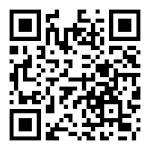
Download POEMS 3 App

Scan the QR code to download APP.
Chat with us
Contact us to Open an Account
Need Assistance? Share your Details and we’ll get back to you
Useful Links
- Payment Instructions
- Need help logging in?
- Open An Account
- Trading Restrictions
- Frequently Asked Questions
- New to Investing?
- Rate Our Website
- POEMS Online Services Quick Reference Guide
- FINRA BrokerCheck
- Call 6531 1555
- [email protected]
- Phillip Investor Centres
- Our Global Presence
- Awards & Accolades
- Privacy & Security
- Risk Disclosure
- Terms & Conditions
- Guide & Cautionary Note
- Best Execution Policy
- Security Advisory
Download POEMS Mobile 3 App
This is provided to you for general information only and does not constitute a recommendation, an offer or solicitation to buy or sell the investment product mentioned. It does not have any regard to your specific investment objectives, financial situation or any of your particular needs. Accordingly, no warranty whatsoever is given and no liability whatsoever is accepted for any loss arising whether directly or indirectly as a result of your acting based on this information.
Investments are subject to investment risks including the possible loss of the principal amount invested. Unit trusts distributed by Phillip Securities Pte Ltd (“PSPL”) are not obligations of, deposits in, or guaranteed by, PSPL or any of its affiliates.
The value of the units in any fund and the income from them may fall as well as rise. Past performance figures as well as any projection or forecast used in this publication are not necessarily indicative of future or likely performance of any unit trust. You should read the prospectus and product highlights sheet before deciding to subscribe for units in the respective fund. A copy of the prospectus can be obtained from the issuer or PSPL, or online at https://www.poems.com.sg/fund-finder/phillip-money-market-fund-534010/
You may wish to obtain advice from a qualified financial adviser, pursuant to a separate engagement, before making a commitment to purchase any of the investment products mentioned herein. In the event that you choose not to obtain advice from a qualified financial adviser, you should assess and consider whether the investment product is suitable for you before proceeding to invest and we do not offer any advice in this regard unless mandated to do so by way of a separate engagement.
This advertisement has not been reviewed by the Monetary Authority of Singapore.

IMPORTANT INFORMATION
This material is provided by Phillip Capital Management (S) Ltd (“ PCM ”) for general information only and does not constitute a recommendation, an offer to sell, or a solicitation of any offer to invest in any of the exchange-traded fund (“ ETF ”) or the unit trust (“ Products ”) mentioned herein. It does not have any regard to your specific investment objectives, financial situation and any of your particular needs. You should read the Prospectus and the accompanying Product Highlights Sheet (“ PHS ”) for key features, key risks and other important information of the Products and obtain advice from a financial adviser (“ FA “) pursuant to a separate engagement before making a commitment to invest in the Products. In the event that you choose not to obtain advice from a FA, you should assess whether the Products are suitable for you before proceeding to invest. A copy of the Prospectus and PHS are available from PCM, any of its Participating Dealers (“ PDs “) for the ETF, or any of its authorised distributors for the unit trust managed by PCM.
An ETF is not like a typical unit trust as the units of the ETF (the “ Units “) are to be listed and traded like any share on the Singapore Exchange Securities Trading Limited (“ SGX-ST ”). Listing on the SGX-ST does not guarantee a liquid market for the Units which may be traded at prices above or below its NAV or may be suspended or delisted. Investors may buy or sell the Units on SGX-ST when it is listed. Investors cannot create or redeem Units directly with PCM and have no rights to request PCM to redeem or purchase their Units. Creation and redemption of Units are through PDs if investors are clients of the PDs, who have no obligation to agree to create or redeem Units on behalf of any investor and may impose terms and conditions in connection with such creation or redemption orders. Please refer to the Prospectus of the ETF for more details.
Investments are subject to investment risks including the possible loss of the principal amount invested. The purchase of a unit in a fund is not the same as placing your money on deposit with a bank or deposit-taking company. There is no guarantee as to the amount of capital invested or return received. The value of the units and the income accruing to the units may fall or rise. Past performance is not necessarily indicative of the future or likely performance of the Products. There can be no assurance that investment objectives will be achieved.
Where applicable, fund(s) may invest in financial derivatives and/or participate in securities lending and repurchase transactions for the purpose of hedging and/or efficient portfolio management, subject to the relevant regulatory requirements. PCM reserves the discretion to determine if currency exposure should be hedged actively, passively or not at all, in the best interest of the Products.
The regular dividend distributions, out of either income and/or capital, are not guaranteed and subject to PCM’s discretion. Past payout yields and payments do not represent future payout yields and payments. Such dividend distributions will reduce the available capital for reinvestment and may result in an immediate decrease in the net asset value (“ NAV ”) of the Products. Please refer to < www.phillipfunds.com > for more information in relation to the dividend distributions.
The information provided herein may be obtained or compiled from public and/or third party sources that PCM has no reason to believe are unreliable. Any opinion or view herein is an expression of belief of the individual author or the indicated source (as applicable) only. PCM makes no representation or warranty that such information is accurate, complete, verified or should be relied upon as such. The information does not constitute, and should not be used as a substitute for tax, legal or investment advice.
The information herein are not for any person in any jurisdiction or country where such distribution or availability for use would contravene any applicable law or regulation or would subject PCM to any registration or licensing requirement in such jurisdiction or country. The Products is not offered to U.S. Persons. PhillipCapital Group of Companies, including PCM, their affiliates and/or their officers, directors and/or employees may own or have positions in the Products. Any member of the PhillipCapital Group of Companies may have acted upon or used the information, analyses and opinions herein before they have been published.
This advertisement has not been reviewed by the Monetary Authority of Singapore.
Phillip Capital Management (S) Ltd (Co. Reg. No. 199905233W) 250 North Bridge Road #06-00, Raffles City Tower ,Singapore 179101 Tel: (65) 6230 8133 Fax: (65) 65383066 www.phillipfunds.com
Two HFA Students Awarded Five College Prose and Poetry Prize for Creative Writing

UMass Amherst undergraduate students Andrea Peter ’25, a comparative literature major, and Livvy Krakower ’24, an English major, were among the 2024 Five College Prose and Poetry Prize recipients honored at a reading and reception April 18 in Hampshire College's Harold F. Johnson Library.
Celebrating creative writing of all genres, the Five College Prose and Poetry Prize, formerly PoetryFest, was reinstated in 2023 after a hiatus due to the pandemic. The contest received 150 total submissions from students representing UMass Amherst, Amherst, Hampshire, Mount Holyoke and Smith colleges, and The Care Center of Holyoke this year.
“For me the most amazing thing about the Five College Poetry and Prose competition is to meet fellow writers from other institutions,” says Krakower, a winner for prose who also won the prize in 2023. “Each college in the consortium is so unique and I am thankful that I have been able to hear pieces I would never hear if not for the competition.”
Peter won a poetry prize in the competition.
“Thanks to Five Colleges, Inc., and our English departments for supporting this work,” says Donna LeCourt, chair of the UMass Amherst English department. “Prizes to undergraduates are important and help to build their reputations in literary and professional communities. The opportunity for our graduate students to judge and manage literary awards provides exceptional professional development and helps distinguish them as creative leaders. I’m happy to see this prize come back to the Five College community.”
“I had a wonderful time judging the prose prize,” says 2024 prose judge and UMass Amherst MFA candidate Danielle Bradley, who was joined on the judging panel by fellow UMass Amherst MFA candidate and poet Ide Thompson ’24. “All of the submissions were impressive, and it was so special to hear many of the winners read their submissions at the reception.”
Global footer
- ©2024 University of Massachusetts Amherst
- Site policies
- Non-discrimination notice
- Accessibility
- Terms of use

Generative A.I. Arrives in the Gene Editing World of CRISPR
Much as ChatGPT generates poetry, a new A.I. system devises blueprints for microscopic mechanisms that can edit your DNA.
The physical structure of OpenCRISPR-1, a gene editor created by A.I. technology from Profluent. Credit... Video by Profluent Bio
Supported by
- Share full article

By Cade Metz
Has reported on the intersection of A.I. and health care for a decade.
- April 22, 2024
Generative A.I. technologies can write poetry and computer programs or create images of teddy bears and videos of cartoon characters that look like something from a Hollywood movie.
Now, new A.I. technology is generating blueprints for microscopic biological mechanisms that can edit your DNA, pointing to a future when scientists can battle illness and diseases with even greater precision and speed than they can today.
Described in a research paper published on Monday by a Berkeley, Calif., startup called Profluent, the technology is based on the same methods that drive ChatGPT, the online chatbot that launched the A.I. boom after its release in 2022 . The company is expected to present the paper next month at the annual meeting of the American Society of Gene and Cell Therapy.
Much as ChatGPT learns to generate language by analyzing Wikipedia articles, books and chat logs, Profluent’s technology creates new gene editors after analyzing enormous amounts of biological data, including microscopic mechanisms that scientists already use to edit human DNA.
These gene editors are based on Nobel Prize-winning methods involving biological mechanisms called CRISPR. Technology based on CRISPR is already changing how scientists study and fight illness and disease , providing a way of altering genes that cause hereditary conditions, such as sickle cell anemia and blindness.

Previously, CRISPR methods used mechanisms found in nature — biological material gleaned from bacteria that allows these microscopic organisms to fight off germs.
“They have never existed on Earth,” said James Fraser, a professor and chair of the department of bioengineering and therapeutic sciences at the University of California, San Francisco, who has read Profluent’s research paper. “The system has learned from nature to create them, but they are new.”
The hope is that the technology will eventually produce gene editors that are more nimble and more powerful than those that have been honed over billions of years of evolution.
On Monday, Profluent also said that it had used one of these A.I.-generated gene editors to edit human DNA and that it was “open sourcing” this editor, called OpenCRISPR-1. That means it is allowing individuals, academic labs and companies to experiment with the technology for free.
A.I. researchers often open source the underlying software that drives their A.I. systems , because it allows others to build on their work and accelerate the development of new technologies. But it is less common for biological labs and pharmaceutical companies to open source inventions like OpenCRISPR-1.
Though Profluent is open sourcing the gene editors generated by its A.I. technology, it is not open sourcing the A.I. technology itself.

The project is part of a wider effort to build A.I. technologies that can improve medical care. Scientists at the University of Washington, for instance, are using the methods behind chatbots like OpenAI’s ChatGPT and image generators like Midjourney to create entirely new proteins — the microscopic molecules that drive all human life — as they work to accelerate the development of new vaccines and medicines.
(The New York Times has sued OpenAI and its partner, Microsoft, on claims of copyright infringement involving artificial intelligence systems that generate text.)
Generative A.I. technologies are driven by what scientists call a neural network , a mathematical system that learns skills by analyzing vast amounts of data. The image creator Midjourney, for example, is underpinned by a neural network that has analyzed millions of digital images and the captions that describe each of those images. The system learned to recognize the links between the images and the words. So when you ask it for an image of a rhinoceros leaping off the Golden Gate Bridge, it knows what to do.
Profluent’s technology is driven by a similar A.I. model that learns from sequences of amino acids and nucleic acids — the chemical compounds that define the microscopic biological mechanisms that scientists use to edit genes. Essentially, it analyzes the behavior of CRISPR gene editors pulled from nature and learns how to generate entirely new gene editors.
“These A.I. models learn from sequences — whether those are sequences of characters or words or computer code or amino acids,” said Profluent’s chief executive, Ali Madani, a researcher who previously worked in the A.I. lab at the software giant Salesforce.
Profluent has not yet put these synthetic gene editors through clinical trials, so it is not clear if they can match or exceed the performance of CRISPR. But this proof of concept shows that A.I. models can produce something capable of editing the human genome.
Still, it is unlikely to affect health care in the short term. Fyodor Urnov, a gene editing pioneer and scientific director at the Innovative Genomics Institute at the University of California, Berkeley, said scientists had no shortage of naturally occurring gene editors that they could use to fight illness and disease. The bottleneck, he said, is the cost of pushing these editors through preclinical studies, such as safety, manufacturing and regulatory reviews, before they can be used on patients.
But generative A.I. systems often hold enormous potential because they tend to improve quickly as they learn from increasingly large amounts of data. If technology like Profluent’s continues to improve, it could eventually allow scientists to edit genes in far more precise ways. The hope, Dr. Urnov said, is that this could, in the long term, lead to a world where medicines and treatments are quickly tailored to individual people even faster than we can do today.
“I dream of a world where we have CRISPR on demand within weeks,” he said.
Scientists have long cautioned against using CRISPR for human enhancement because it is a relatively new technology that could potentially have undesired side effects, such as triggering cancer, and have warned against unethical uses, such as genetically modifying human embryos.
This is also a concern with synthetic gene editors. But scientists already have access to everything they need to edit embryos.
“A bad actor, someone who is unethical, is not worried about whether they use an A.I.-created editor or not,” Dr. Fraser said. “They are just going to go ahead and use what’s available.”
Cade Metz writes about artificial intelligence, driverless cars, robotics, virtual reality and other emerging areas of technology. More about Cade Metz
Explore Our Coverage of Artificial Intelligence
News and Analysis
Saudi Arabia is plowing money into glitzy events, computing power and artificial intelligence research, putting it in the middle of an escalating U.S.-China struggle for technological influence.
Microsoft gave more signs that its hefty investments in A.I. were beginning to bear fruit, as it reported a 17 percent jump in revenue and a 20 percent increase in profit for the first three months of the year.
Meta projected that revenue for the current quarter would be lower than what Wall Street anticipated and said it would spend billions of dollars more on its artificial intelligence efforts, even as it reported robust revenue and profits for the first three months of the year.
The Age of A.I.
A new category of apps promises to relieve parents of drudgery, with an assist from A.I . But a family’s grunt work is more human, and valuable, than it seems.
Despite Mark Zuckerberg’s hope for Meta’s A.I. assistant to be the smartest , it struggles with facts, numbers and web search.
Much as ChatGPT generates poetry, a new A.I. system devises blueprints for microscopic mechanisms that can edit your DNA.
Could A.I. change India’s elections? Avatars are addressing voters by name, in whichever of India’s many languages they speak. Experts see potential for misuse in a country already rife with disinformation.
Which A.I. system writes the best computer code or generates the most realistic image? Right now, there’s no easy way to answer those questions, our technology columnist writes .
Advertisement
Trump's defense used a jury consultant to research and help them select jurors

The New Yorkers who could decide Donald Trump’s fate were vetted in real time on Friday by the former president’s defense team.
As the potential alternate jurors were being questioned by prosecutors seeking to convict Trump of illegally paying hush money to a porn star , and by defense attorneys trying to keep him out of jail, a jury consultant hired by Trump's legal team was watching the candidates closely for telltale signs of possible bias while simultaneously feeding the defense attorneys her impressions.
Follow along for live updates
Meanwhile, other jury consultants say, it is likely that a team of researchers working with the jury consultant were doing social media and other online searches to fill out the picture of every potential juror and sending that information to Trump’s lawyers in the courtroom.
“All this has to happen relatively quickly,” said veteran jury consultant Jo-Ellan Dimitrius of Dimitrius & Associates, who has been following the case and identified the firm working for Trump as Magna Legal Services.
The Philadelphia-based firm did not respond to a call from NBC News but court records show that Magna served as Trump’s jury consultant when was ordered to pay $83.3 million in damages to writer E. Jean Carroll for defaming her in 2019.
It was not immediately clear if the Manhattan District Attorney’s office used its own jury consultant to vet jurors and a spokesperson for the agency did not return numerous phone calls from NBC News.
By midday, jury selection had been completed and Trump's first trial was heading for opening arguments.
Using jury consultants for vetting has become a fairly common practice.
“In my experience, there’s usually a consultant sitting behind the lawyers with a laptop who is feeding information to the lawyer doing the questioning of jurors,” Dimitrius said. “They usually have the home office doing the social media checks and other searches because the primary role of the consultant in the courtroom is to listen and watch the jurors and give feedback to the lawyers.”
Sometimes the background checks of potential jurors are being done even before the questioning begins, Dimitrius said.
“Generally on the morning of jury selection you get a list of potential jurors,” she said. “So we will take an iPhone photo of the list and send it back to the office where they’ll start their searches.”
Tampa-based jury consultant Michael Boucher of TCS, who has worked on a number of high-profile cases in New York City, like former Alaska Gov. Sarah Palin’s failed libel case versus the New York Times, echoed Dimitrius.
“In a case like this, we would set up a laptop on the podium and use a messaging app to stay in contact with the lawyers questioning the jurors,” Boucher said. “Not only are you feeding the lawyer information, you are finding on the jurors online, you’re trying to help guide the lawyer asking the questions. Lawyers, at times, sometimes get too far into the weeds and they need assistance so they can come up with follow-up questions.”
At the same time, Boucher said, “We’re watching the reactions of the other jurors waiting to be questioned and feeding that information to our legal team. That way, when the next potential juror steps up we already have a sense of where they stand.”
Boucher said in his experience Manhattan jury pools tend to be sophisticated, well-educated and thoughtful. But cases involving polarizing figures like Trump or Palin “sometime attract what we call 'motivated jurors,' with strong feelings either for or against" them.
“It’s very hard to find anybody who doesn’t have an opinion about Trump,” he said.
NBC News Legal Analyst Danny Cevallos, an attorney who practices in New York and elsewhere, agreed.
“In virtually every other case in the world, there’s not a strong chance that the jurors have tweeted about the defendant or posted on social media," Cevallos said. "This is the rare one-in-a-million case where there’s a good chance all of us have retweeted or tweeted something about Donald Trump."
Renato Stabile, managing director at Dubin Research & Consulting in New York City, said the ability to track social media has revolutionized the way juries get picked — and how jury consultants do their jobs.
“Before you just had to rely on what jurors said in court, and I think lawyers depended a lot more on their experience and gut, and maybe unfortunately, stereotypes that were either correct or incorrect and their past experience," Stabile said. "Now you just get such a better sense of what jurors are really all about based on the articles they’re liking, what they’re reposting."
Examining social media is "probably the most important part of jury selection,” said David Oscar Markus, a criminal defense attorney who, among others, successfully defended former Tallahassee mayor Andrew Gillum against charges of lying to the FBI .
“Lots of folks will come into court and say, ‘Yes, of course, I can be fair,’ or, ‘I have feelings about this one way or the other, but I can put all those aside and give the prosecution and defense a fair shake'," Markus said. "But then, once you see posts, even if they’re old posts, they reveal sort of the jurors’ true feelings.”
Lisa Rubin and Corky Siemaszko reported from New York City, Megan Lebowitz reported from Washington, D.C.
Lisa Rubin is an MSNBC legal correspondent and a former litigator.
Megan Lebowitz is a politics reporter for NBC News.
Corky Siemaszko is a senior reporter for NBC News Digital.
Numbers, Facts and Trends Shaping Your World
Read our research on:
Full Topic List
Regions & Countries
- Publications
- Our Methods
- Short Reads
- Tools & Resources
Read Our Research On:
In Tight Presidential Race, Voters Are Broadly Critical of Both Biden and Trump
About half of voters say that, if given the chance, they would replace both candidates on the ballot, table of contents.
- The state of the 2024 presidential race
- Other findings: Biden’s job approval ticks up, Trump’s election-related criminal charges
- Educational differences in candidate support
- What are 2020 voters’ preferences today?
- How Biden’s supporters view his personal traits
- How Trump’s supporters view his personal traits
- Views of Biden’s presidency and retrospective evaluations of Trump’s time in office
- Attention to the candidates
- Does it matter who wins?
- What if voters could change the presidential ballot?
- How important is it for the losing candidate to publicly acknowledge the winner?
- 4. Joe Biden’s approval ratings
- Acknowledgments
- The American Trends Panel survey methodology
- Validated voters

Pew Research Center conducted this study to understand voters’ views on the 2024 presidential election, as well how the public views President Joe Biden. For this analysis, we surveyed 8,709 adults – including 7,166 registered voters – from April 8 to April 14, 2024. Everyone who took part in this survey is a member of the Center’s American Trends Panel (ATP), an online survey panel that is recruited through national, random sampling of residential addresses. This way nearly all U.S. adults have a chance of selection. The survey is weighted to be representative of the U.S. adult population by gender, race, ethnicity, partisan affiliation, education and other categories. Read more about the ATP’s methodology .
Here are the questions used for this report , along with responses, and the survey methodology .
As the 2024 presidential race heats up, American voters face a similar set of choices as they did four years ago – and many are not happy about it.
With the election still more than six months away, a new Pew Research Center survey finds that the presidential race is virtually tied : 49% of registered voters favor Donald Trump or lean toward voting for him, while 48% support or lean toward Joe Biden.
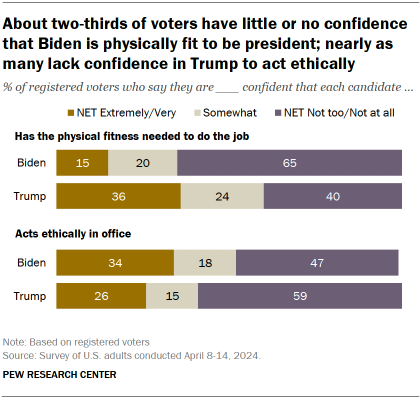
A defining characteristic of the contest is that voters overall have little confidence in either candidate across a range of key traits, including fitness for office, personal ethics and respect for democratic values.
Where Trump has the advantage: More than a third of voters say they are extremely or very confident that Trump has the physical fitness (36%) and mental fitness (38%) needed to do the job of president.
Far fewer say the same of Biden (15% are at least very confident in his physical fitness; 21% are extremely or very confident in his mental fitness). Majorities say they are not too or not at all confident in Biden’s physical and mental fitness.
Where Biden has the advantage: More voters are extremely or very confident in Biden (34%) than in Trump (26%) to act ethically in office. And while 38% say they are at least very confident in Biden to respect the country’s democratic values, fewer (34%) express that level of confidence in Trump. The survey was conducted before the start of Trump’s “hush money” trial in New York City .
( Read more about voters’ views of Biden and Trump in Chapter 2. )
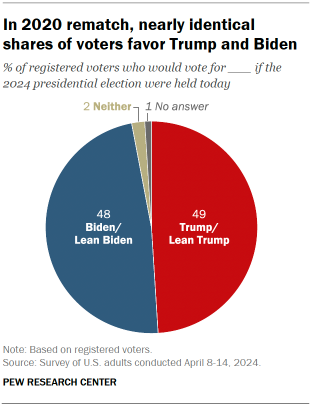
The new Center survey of 8,709 adults – including 7,166 registered voters – conducted April 8-14, 2024, finds large divides in voters’ candidate preference by age, education, and race and ethnicity. As was the case in 2020, younger voters and those with a four-year college degree are more likely to favor Biden than Trump.
Older voters and those with no college degree favor Trump by large margins.
Among racial and ethnic groups:
- White voters favor Trump (56%) over Biden (42%) by a wide margin.
- Roughly three-quarters of Black voters (77%) support Biden, while 18% back Trump.
- Hispanic voters are more evenly divided – 52% favor Biden, while 44% back Trump.
- Asian voters favor Biden (59%) over Trump (36%).
( Read more about voters’ candidate preferences in Chapter 1. )
Most voters who turned out in 2020 favor the same candidate in 2024. Among validated 2020 voters, overwhelming majorities of those who cast ballots for Biden (91%) and Trump (94%) support the same candidate this year. Registered voters who did not vote in 2020 are about evenly divided: 48% back Trump, while 46% support Biden.
A majority of voters say “it really matters who wins” the 2024 race. Today, 69% of voters say it really matters which candidate wins the presidential contest this November. This is somewhat smaller than the share who said this in April 2020 about that year’s election (74%). Nearly identical shares of Biden’s and Trump’s supporters say the outcome of the presidential race really matters.
About half of voters would replace both Biden and Trump on the 2024 ballot
Reflecting their dissatisfaction with the Biden-Trump matchup, nearly half of registered voters (49%) say that, if they had the ability to decide the major party candidates for the 2024 election, they would replace both Biden and Trump on the ballot .
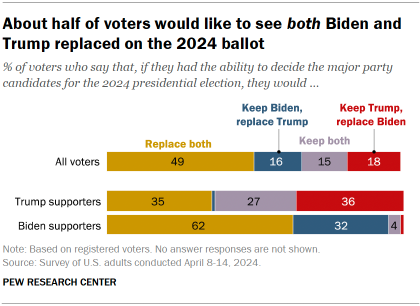
Biden’s supporters are especially likely to say they would replace both candidates if they had the chance. Roughly six-in-ten (62%) express this view, compared with 35% of Trump supporters.
There also are stark age differences in these views: 66% of voters under 30 say they would replace both candidates if they had the chance, compared with 54% of those ages 30 to 49 and fewer than half (43%) of those 50 and older.
( Read more about voters’ feelings toward the upcoming election in Chapter 3. )
Evaluations of the Biden and Trump presidencies
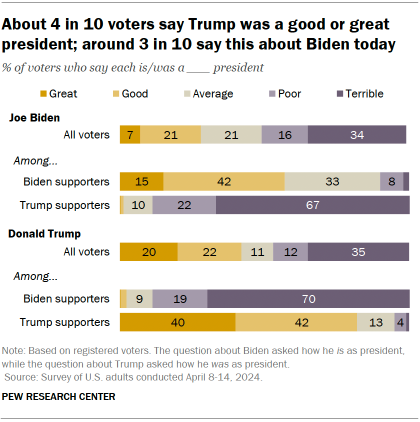
- 42% of voters overall say Trump was a good or great president, while 11% say he was average. This is a modest improvement since March 2021, two months after he left office.
- 28% of voters say Biden is a good or great president, while 21% say he is average. These views are mostly on par with June 2020 assessments of the kind of president Biden would be – but today, a smaller share of voters say he is average.
( Read more about ratings of Biden’s and Trump’s presidencies in Chapter 1. )
- Biden’s approval among the general public: Today, Biden’s approval rating sits at 35% – roughly on par with his rating in January (33%). His job rating has climbed slightly among Democrats over that period, however. Today, 65% of Democrats approve of him – up 4 percentage points since January. ( Read more about Biden’s approval rating in Chapter 4. )
- Conceding the presidential election: A majority of voters say it is important that the losing candidate in November publicly acknowledge the winner as the legitimate president. But Trump’s supporters are far less likely than Biden’s to say it is very important (44% vs. 77%). ( Read more about voters’ views on election concession in Chapter 3. )
Trump’s criminal charges related to the 2020 election
As Trump faces charges that he sought to overturn the outcome of the 2020 election, 45% of Americans say they think Trump’s actions broke the law. This compares with 38% who say his actions did not break the law – including 15% who say his actions were wrong but not illegal, and 23% who say he did nothing wrong. Nearly two-in-ten are not sure.
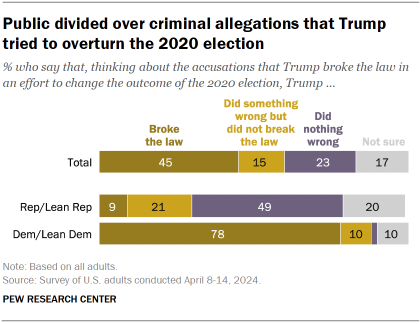
Democrats mostly say Trump broke the law; Republicans are more divided. An overwhelming majority of Democrats and Democratic-leaning independents (78%) say Trump’s actions in seeking to change the outcome of the 2020 election broke the law.
Among Republicans and Republican leaners:
- 49% say Trump did nothing wrong.
- 21% say he did something wrong but did not break the law.
- 9% say Trump broke the law.
- 20% are not sure.
Sign up for our weekly newsletter
Fresh data delivery Saturday mornings
Sign up for The Briefing
Weekly updates on the world of news & information
- Donald Trump
- Election 2024
- Partisanship & Issues
- Presidential Approval
- Voter Demographics
- Voter Participation
Changing Partisan Coalitions in a Politically Divided Nation
About 1 in 4 americans have unfavorable views of both biden and trump, 2024 presidential primary season was one of the shortest in the modern political era, americans more upbeat on the economy; biden’s job rating remains very low, key facts about hispanic eligible voters in 2024, most popular, report materials.
- April 2024 Biden Job Approval Detailed Tables
1615 L St. NW, Suite 800 Washington, DC 20036 USA (+1) 202-419-4300 | Main (+1) 202-857-8562 | Fax (+1) 202-419-4372 | Media Inquiries
Research Topics
- Age & Generations
- Coronavirus (COVID-19)
- Economy & Work
- Family & Relationships
- Gender & LGBTQ
- Immigration & Migration
- International Affairs
- Internet & Technology
- Methodological Research
- News Habits & Media
- Non-U.S. Governments
- Other Topics
- Politics & Policy
- Race & Ethnicity
- Email Newsletters
ABOUT PEW RESEARCH CENTER Pew Research Center is a nonpartisan fact tank that informs the public about the issues, attitudes and trends shaping the world. It conducts public opinion polling, demographic research, media content analysis and other empirical social science research. Pew Research Center does not take policy positions. It is a subsidiary of The Pew Charitable Trusts .
Copyright 2024 Pew Research Center
Terms & Conditions
Privacy Policy
Cookie Settings
Reprints, Permissions & Use Policy

IMAGES
VIDEO
COMMENTS
This paper articulates the findings of a two-year Canadian federally-funded postdoctoral study — Poetic inquiry in qualitative research: A critical survey — on the use of poetry in social ...
There are reports of beneficial uses of poetry qua poetry in psychological and therapeutic settings from dementia, ... This special issue, therefore, presents cutting-edge interdisciplinary research on poetry and its uses by experts in education, literary studies, psychology, psychoanalysis, philosophy and actor training in an attempt to start ...
The field of social science research has seen a blossoming of arts-based researchers who utilize poetry throughout the research process (Prendergast, 2009). Faulkner (2019) positions poetry as a legitimate research method, viewing poetic inquiry as a valuable research tool, one that acts as both research method and outcome. In general terms ...
For Howe, researching and writing are complementary, mutually affecting acts. Howe's poet-researcher is a scout, a rover, a trespasser unsettling the wilderness of American literary history. Her poems and essays continually enact that anticipatory moment before discovery, of making connections, before anything is ever fixed into ideas.
Discussion has occurred around what constitutes quality research poetry, with some direction on how a researcher, who is a novice poet, might go about writing good enough research poetry. In an effort to increase the existing conversation, the authors review research poetry literature and ideas from art poets on how to read, write, and revise poetry.
9. Exploring Themes. 10. Analyzing Discourse and Context. 11. Finding Inspiration. Writing a poetry research paper can be an intimidating task for students. Even for experienced writers, the process of writing a research paper on poetry can be daunting. However, there are a few helpful tips and guidelines that can help make the process easier.
Poetic inquiry, or the use of poetry in research, is an arts-based approach that emerged in response to the above critiques of much traditional qualitative research (Furman et al. 2006; Glesne 1997; Prendergast 2004; Richardson 2002). Research poems creatively combine the basic premise of qualitative research with the craft of poetry (Leavy 2015).
It is defined broadly as a reseach process and research product. As a process, poetic inquiry is the foundation of or central component to research endeavors where poetry can be the data source, the analytical and interpretative lenses, and/or the presentation. As a product, poetic inquiry results in poems singularly constructed by the ...
Tips for Researching Poetry. Among many other delightful signs of spring, April brings us National Poetry Month. Springtime during a pandemic is a contradictory mix of delights and shadows-an imperfectly perfect opportunity for poetry.. This is the 25th year we've been graced with National Poetry Month.If you regularly recognize National Poetry Month, it might be a welcome reminder of ...
The research study group consists of 56 students, 26 in the experimental group and 30 in the control group, studying in the third grade. While ABPS was ... the practice process based on poems. As a result of the research, it was determined that the students in the experimental group made more progress in all sub-dimensions of creative writing ...
This page addresses the research process -- the things that should be done before the actual writing of the paper -- and strategies for engaging in the process. Although this LibGuide focuses on researching poems or poetry, this particular page is more general in scope and is applicable to most lower-division college research assignments.
ENG 102 - Poetry Research. This guide is designed to help you complete an English 102 research paper about a poem. 4. Find Sources. Once you have narrowed your topic and thought about keywords, try searching the databases below for potential sources you can use to support your thesis. If your keywords aren't working ask a librarian for help!
ENG 102 - Poetry Research. This guide is designed to help you complete an English 102 research paper about a poem. Evaluate Your Sources. Look for the following information about your source. You may not always find everything, but these are key points to consider. If you cannot find this information about your source, then it may not be a good ...
A poetry research paper is an insight into the meaning hidden behind either common or extraordinary word combinations. Besides, the research papers are more complicated than essays. This assignment requires you to do thorough work, to be attentive to the details and apply the available information, theory, and even facts from the author's ...
ENG 102 - Poetry Research; 7. Write Your Paper; Search this Guide Search. ENG 102 - Poetry Research. This guide is designed to help you complete an English 102 research paper about a poem. Write Your Paper/Project Getting Started. Writing Fundamentals from Writer's Reference Center.
See our pick of some of the best poems ever created, or find a poem using our Poem Explorer Tool. ... Alzheimer's Research. Great Ormond Street Hospital. Ocean Conservancy. World Animal Protection. Read more about Charity. General. About. Contact. Help Center. Request an Analysis. Charity.
Step-by-step Instructions for Writing the Poetry Research Paper. It can be challenging to write a research paper about poetry if you are given the assignment. But if you take the appropriate method, you can divide it into manageable steps. The following is a step-by-step tutorial on how to write an effective poetry research paper: Step 1 ...
Poems; Mobile Apps; ... For Research Report and Business enquiry. Report Review of March 2024 Tuesday, April 23, 2024 38. Report Review of March 2024 Weekly Special - 3306 JNBY Design Limited Sectors: Utilities, Commodity & Metals ( Margaret Li ), TMT, Semiconductors, Consumer & Healthcare (Eric Li) ...
Best/Easiest Poems to Analyze. 1 Fire and Ice by Robert Frost. 2 Mother to Son by Langston Hughes. 3 A Dream Within a Dream by Edgar Allan Poe. 4 Still I Rise by Maya Angelou. 5 Do Not Go Gentle Into That Good Night by Dylan Thomas. 6 The New Colossus by Emma Lazarus. 7 If You Forget Me by Pablo Neruda.
Join our Singapore Equity Research Community on POEMS Mobile 3 App for the latest research reports, market updates, insights and more. Click to join! Download POEMS 3 App. Scan the QR code to download APP. ... POEMS makes no representations nor has any supervision or control over the quality, content, reliability or security of the third party ...
Celebrating creative writing of all genres, the Five College Prose and Poetry Prize, formerly PoetryFest, was reinstated in 2023 after a hiatus due to the pandemic. The contest received 150 total submissions from students representing UMass Amherst, Amherst, Hampshire, Mount Holyoke and Smith colleges, and The Care Center of Holyoke this year.
According to a report by Interesting Engineering, the Poetry Camera is powered by a Raspberry Pi single-board computer and leverages OpenAI's GPT-4 model — merging hardware with AI technology. ...
Americans' ratings of Joe Biden's job performance remain more negative than positive and have been largely stable over the last year: Today, 35% of Americans approve of his performance, while 62% disapprove. About two-thirds of Democrats and Democratic-leaning independents (65%) approve of Biden ...
Described in a research paper published on Monday by a Berkeley, Calif., startup called Profluent, the technology is based on the same methods that drive ChatGPT, the online chatbot that launched ...
Child pornography generated by artificial intelligence (AI) could overwhelm an already inundated reporting system for online child sexual abuse material, a new report from the Stanford Internet Obs…
Donald Trump's defense team in his hush money trial vetted potential jurors using a jury consultant and researchers to dig into their social media profiles.
Pew Research Center conducted this study to understand voters' views on the 2024 presidential election, as well how the public views President Joe Biden. For this analysis, we surveyed 8,709 adults - including 7,166 registered voters - from April 8 to April 14, 2024. ... Here are the questions used for this report, along with responses ...